This is the last article in a series that summarizes the simulated crop stages and yield forecasts across the Corn Belt. To evaluate, in “real-time,” the impact of this season’s weather on corn yield and its spatial variability across the Corn Belt, simulations of 2022 real-time crop stage were performed for 40 locations across the US Corn Belt using the UNL Hybrid-Maize crop model; the data can be seen in Table 1. Details on the UNL Hybrid-Maize crop model and the underpinning methodology to simulate phenology and forecast end-of-season yields is described in a previous article.
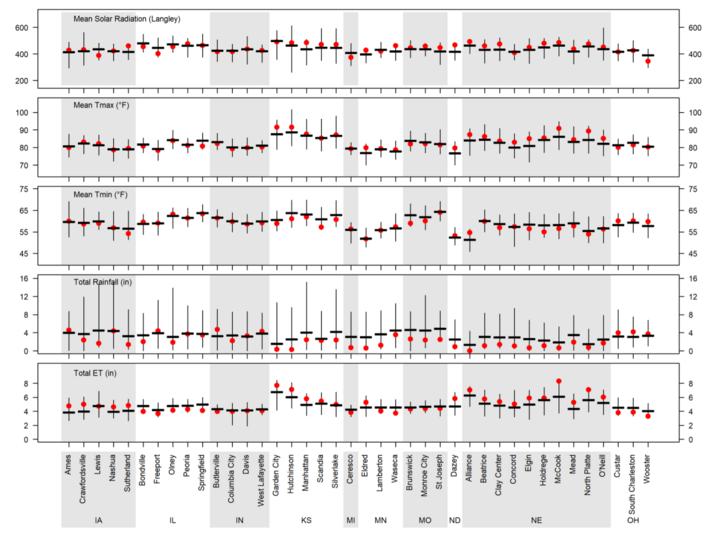
| Location | Water regime | Long-term average yield (bu/ac) § | Range of Yp forecasts as of Sept. 14 (bu/ac)¶ 25th | Range of Yp forecasts as of Sept. 14 (bu/ac)¶ 75th | Probability (%) of 2022 yield to be: Below (relative to the long-term Yp)† | Probability (%) of 2022 yield to be: Near (relative to the long-term Yp)† | Probability (%) of 2022 yield to be: Above (relative to the long-term Yp)† | Simulated current crop stage* | |
|---|---|---|---|---|---|---|---|---|---|
| NE | Alliance | Irrigated | 193 | Black layer on Aug. 30. Final yield: 183 bu/ac | Matured | ||||
| Beatrice | Dryland | 161 | Black layer on Aug. 23. Final yield: 113 bu/ac | Matured | |||||
| Irrigated | 230 | Black layer on Aug. 27. Final yield: 199 bu/ac | Matured | ||||||
| Clay Center | Dryland | 157 | Black layer on Aug. 27. Final yield: 71 bu/ac | Matured | |||||
| Irrigated | 245 | Black layer on Sept. 2. Final yield: 233 bu/ac | Matured | ||||||
| Concord | Dryland | 174 | Black layer on Aug. 30. Final yield: 106 bu/ac | Matured | |||||
| Irrigated | 249 | Black layer on Sept. 6. Final yield: 236 bu/ac | Matured | ||||||
| Elgin | Irrigated | 252 | Black layer on Sept. 8. Final yield: 239 bu/ac | Matured | |||||
| Holdrege | Dryland | 113 | Black layer on Aug. 25. Final yield: 89 bu/ac | Matured | |||||
| Irrigated | 242 | Black layer on Aug. 31. Final yield: 225 bu/ac | Matured | >||||||
| McCook | Dryland | 88 | Black layer on Aug. 18. Final yield: 35 bu/ac | Matured | |||||
| Irrigated | 225 | Black layer on Aug. 20. Final yield: 191 bu/ac | Matured | ||||||
| Mead | Dryland | 182 | Black layer on Aug. 30. Final yield: 130 bu/ac | Matured | |||||
| Irrigated | 235 | Black layer on Aug. 30. Final yield: 215 bu/ac | Matured | ||||||
| North Platte | Dryland | 90 | Black layer on Aug. 27. Final yield: 51 bu/ac | Matured | |||||
| Irrigated | 234 | Black layer on Aug. 31. Final yield: 221 bu/ac | Matured | ||||||
| O'Neill | Irrigated | 227 | Black layer on Aug. 29. Final yield: 174 bu/ac | Matured | |||||
| IA | Ames | Dryland | 229 | Black layer on Sept. 10. Final yield: 198 bu/ac | Matured | ||||
| Crawfordsville | Dryland | 230 | Black layer on Aug. 29. Final yield: 135 bu/ac | Matured | |||||
| Lewis | Dryland | 209 | Black layer on Sept. 4. Final yield: 140 bu/ac | Matured | |||||
| Nashua | Dryland | 228 | 247 | 263 | 0% | 39% | 61% | R5, Dent | |
| Sutherland | Dryland | 210 | Black layer on Sept. 5. Final yield: 150 bu/ac | Matured | |||||
| IL | Bondville | Dryland | 235 | 230 | 234 | 0% | 100% | 0% | R6, Black layer |
| Freeport | Dryland | 212 | 237 | 243 | 0% | 9% | 91% | R5, Dent | |
| Olney | Dryland | 190 | Black layer on Aug. 27. Final yield: 209 bu/ac | Matured | |||||
| Peoria | Dryland | 211 | Black layer on Sept. 7. Final yield: 235 bu/ac | Matured | |||||
| Springfield | Dryland | 179 | Black layer on Sept. 1. Final yield: 242 bu/ac | Matured | |||||
| IN | Butlerville | Dryland | 224 | Black layer on Sept. 8. Final yield: 221 bu/ac | Matured | ||||
| Columbia City | Dryland | 224 | 242 | 252 | 0% | 53% | 47% | R5, Dent | |
| Davis | Dryland | 231 | 229 | 235 | 0% | 100% | 0% | R5, Dent | |
| West Lafayette | Dryland | 238 | 217 | 225 | 0% | 100% | 0% | R5, Dent | |
| KS | Garden City | Irrigated | 218 | Black layer on Aug. 15. Final yield: 178 bu/ac | Matured | ||||
| Hutchinson | Dryland | 100 | Black layer on Aug. 2. Final yield: 61 bu/ac | Matured | |||||
| Manhattan | Dryland | 136 | Black layer on Aug. 13. Final yield: 156 bu/ac | Matured | |||||
| Scandia | Dryland | 131 | Black layer on Aug. 31. Final yield: 83 bu/ac | Matured | |||||
| Irrigated | 226 | Black layer on Sept. 5. Final yield: 249 bu/ac | Matured | ||||||
| Silverlake | Dryland | 141 | Black layer on Aug. 15. Final yield: 144 bu/ac | Matured | |||||
| Irrigated | 209 | Black layer on Aug. 21. Final yield: 218 bu/ac | Matured | ||||||
| MI | Ceresco | Dryland | 180 | 181 | 200 | 0% | 67% | 33% | R4, Dough |
| MN | Eldred | Dryland | 115 | 80 | 84 | 100% | 0% | 0% | R5, Dent |
| Lamberton | Dryland | 212 | 203 | 213 | 0% | 100% | 0% | R5, Dent | |
| Waseca | Dryland | 219 | 259 | 277 | 0% | 2% | 98% | R5, Dent | |
| MO | Brunswick | Dryland | 181 | Black layer on Sept. 6. Final yield: 182 bu/ac | Matured | ||||
| Monroe City | Dryland | 174 | Black layer on Sept. 6. Final yield: 216 bu/ac | Matured | |||||
| St. Joseph | Dryland | 167 | Black layer on Sept. 2. Final yield: 215 bu/ac | Matured | |||||
| ND | Dazey | Dryland | 109 | 79 | 84 | 100% | 0% | 0% | R5, Dent |
| OH | Custar | Dryland | 208 | 223 | 246 | 0% | 46% | 54% | R5, Dent |
| South Charleston | Dryland | 216 | 240 | 250 | 0% | 16% | 84% | R5, Dent | |
| Wooster | Dryland | 210 | 207 | 237 | 0% | 62% | 38% | R5, Dent | |
§Long-term (last 20-plus years) potential yield at each location and surrounding area.
¶ Range of forecasted 2022 potential yields based on average planting date in 2022, indicating the potential yields in the 25th and 75th percentile of the potential yield distribution (associated with respective adverse and favorable weather scenarios during the rest of the season).
† Probability of obtaining a 2022 yield below (10%) than the long-term potential yield at each location.
Crop Stages and Weather Conditions During the Last Four Weeks
Corn has reached black layer at all irrigated sites and at most of rainfed locations of the Corn Belt, except for those situated along the north and eastern fringes of the region (Figure 2).
During the last four weeks, most sites across the Corn Belt exhibited near-normal temperature, although above-normal daily temperatures were registered in the western (NE and KS) and northern (ND) states.
While sites in the eastern fringe of the Corn Belt (OH, IN, IL) exhibited near-normal rainfall, the majority of locations had below-normal rainfall. A summary of weather conditions during the past three weeks is shown in Figure 1.

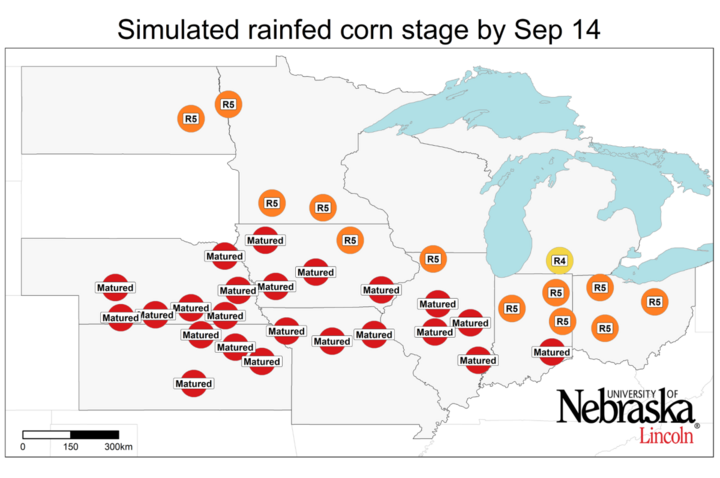
Near but Below Average Yields in Irrigated Corn
Forecasted end-of-season irrigated yields are shown in Figure 3 and 4. Four sites (out of 13) exhibited below-average yields (that is with a difference >10%). Compared with our previous forecast, above-average temperature during the past four weeks in NE further reduced the forecasted yield for 2022. Expected yields in NE are consistently lower than historical average, with an average difference of 10%. Overall, the irrigated maize yield potential forecasted for the current 2022 season is 5% lower, on average, compared to that in the previous (2021) season.
Rainfed Corn: Yield Potential is Highly Variable Across Rainfed Sites
Forecasted end-of-season yields for rainfed corn indicate above-average yields at only 22% (eight out of 36) of the sites, and these were distributed in the southern fringe of the region (eastern KS and MO), western IL, southern OH and southeastern MN (Figure 3 and 4).
In contrast, 42% of the sites (15 out of 36) exhibited below-average yields. These sites with below-average yield were located in NE, ND, most of IA, central KS and northern MN.
The remaining 13 sites, mostly located in the eastern part of the Corn Belt (eastern IL, IN and OH), showed a high probability of near-average yield.
Overall, this year’s scenario looks similar to last year’s forecast but 9% lower than the long-term average. Compared to the 2021 season, one-third of the rainfed sites exhibited a decrease in yield potential that was larger than 5%, especially at sites in NE, IA and KS. Another one-third of the sites improved yields by at least 5%, compared with the 2021 season, especially in MO, OH, IN, MN and ND.
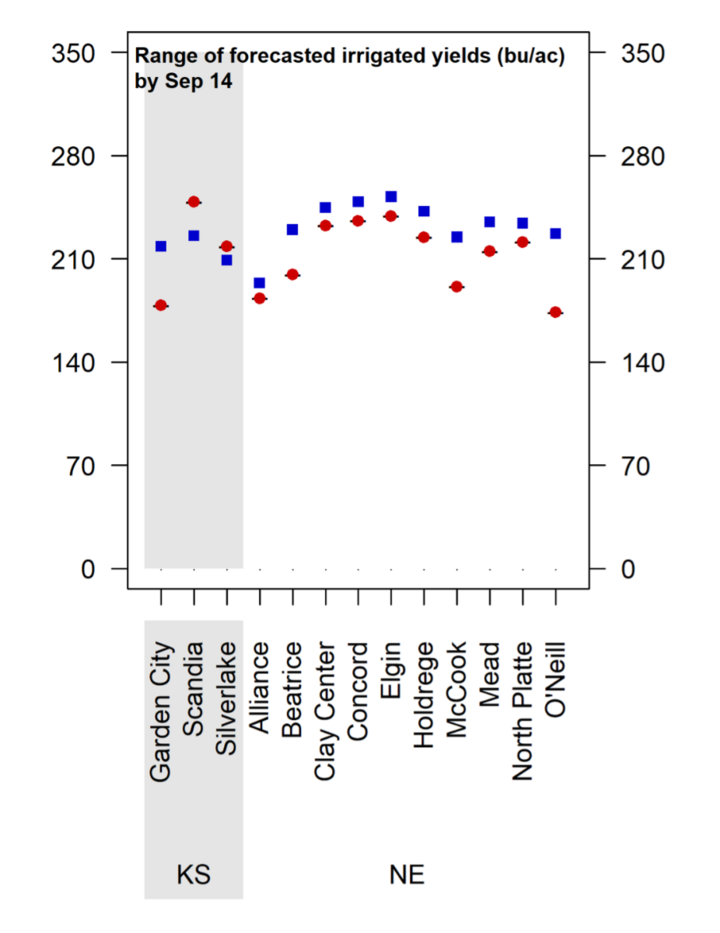
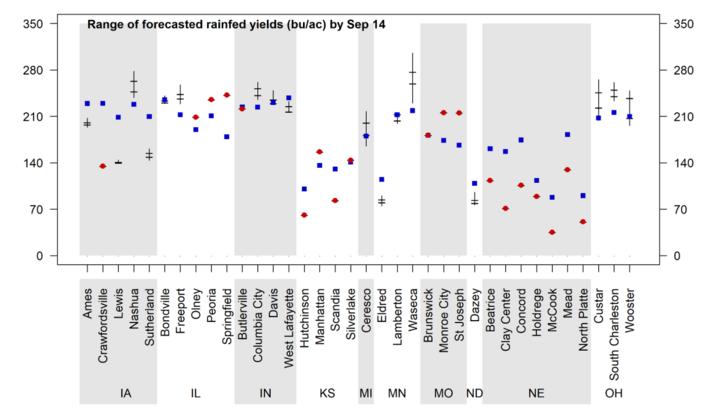
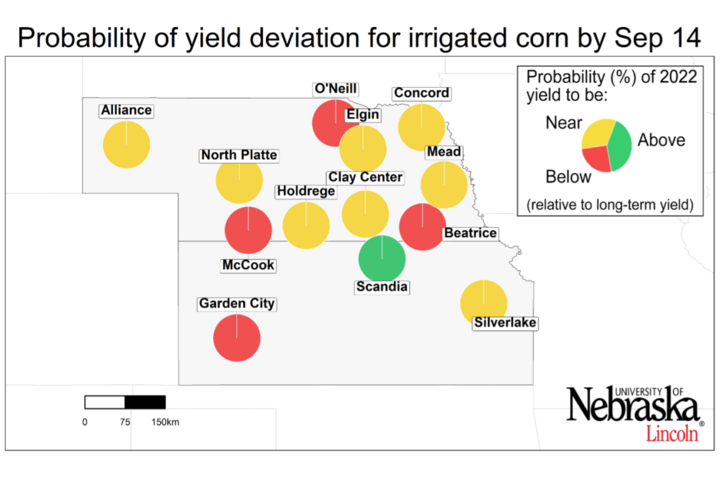
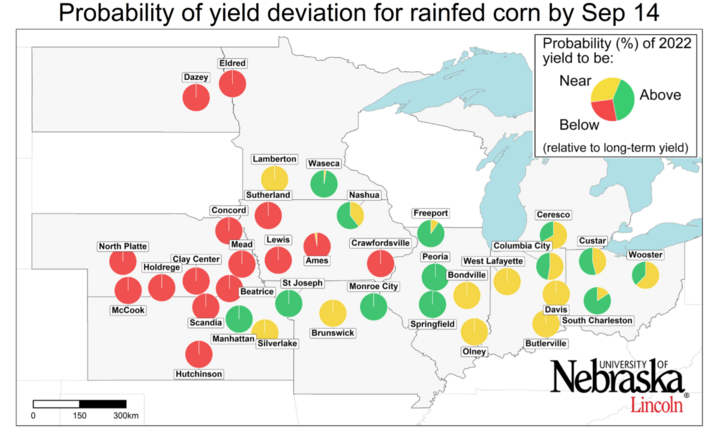
Conclusions
Our forecasted yield potential this season seems to be almost 10% below the historical average for both rainfed and irrigated corn overall. The USDA also forecasts that 2022 corn yield will be lower than that predicted from the long-term historical trend.
Our forecast suggests a near but below-average year for most irrigated sites, although one-third of them can expect yields to be well below (>10%) the historical average.
For rainfed corn, the scenario is diverse across regions. Most sites in the eastern part of the Corn Belt have a high probability of near-average yields. Above-average yield is expected at eight locations in eastern KS, MO, western IL, southern OH and southeastern MN. In contrast, 13 sites located in northern and western fringes of the Corn Belt and IA exhibit a high probability of below-average yields.
Note that these forecasts do not take into consideration problems with stand emergence, hail/flooding damage, replanting situations, disease or nitrate leaching. In fields negatively affected by these constraints, actual yields will be lower than estimates provided here.
It is important to keep in mind that yield forecasts are not field specific and, instead, represent an estimate of average on-farm yield for a given location and surrounding area in absence of the yield-reducing factors mentioned here. Likewise, crop stages and forecasted yields will deviate from those reported here in fields with planting dates or hybrid maturities that differ markedly from those used as the basis for these forecasts.
